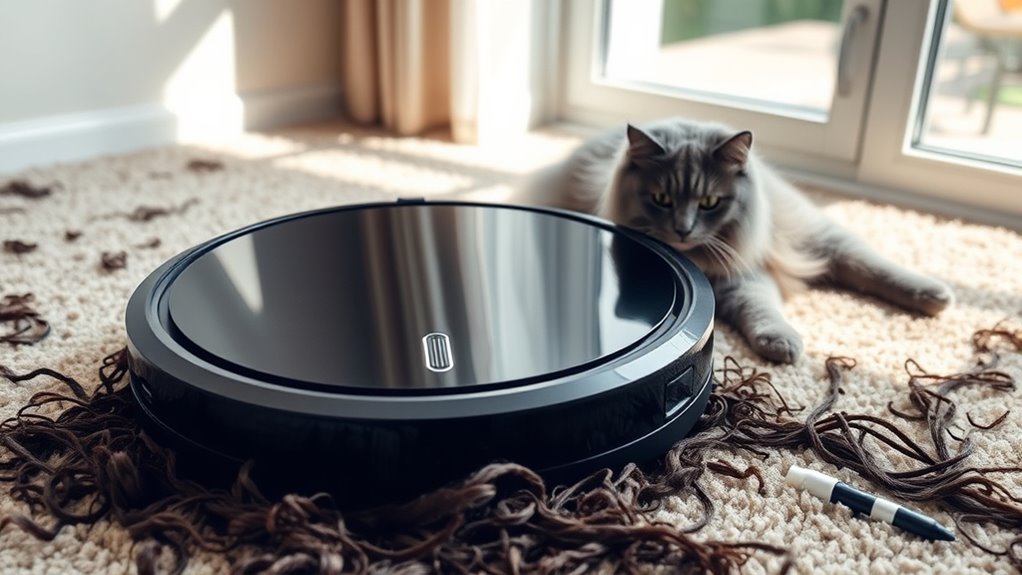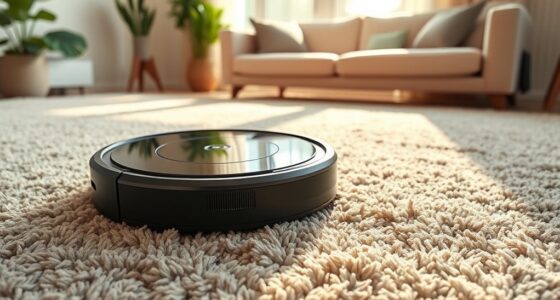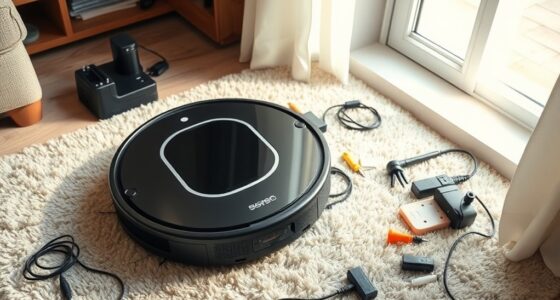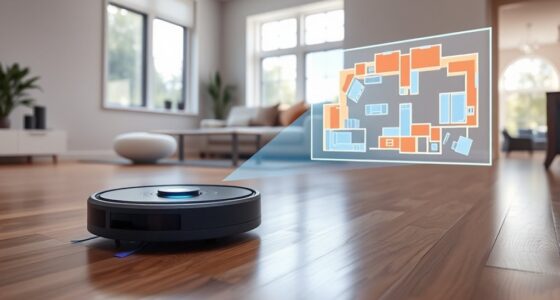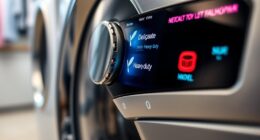Robot vacuums can handle pet hair well, especially newer models with strong suction, long battery life, and quiet operation. They’re designed to cover large areas and perform multiple cleaning cycles without frequent recharges. Plus, quieter models prevent pets from getting stressed during cleaning. If you want to see how these features work in real-world tests and find the best options for your home, there’s more to discover below.
Key Takeaways
- Many robot vacuums are designed with strong suction to pick up pet hair effectively.
- Longer battery life allows vacuums to cover larger areas and handle multiple cleaning cycles for pet owners.
- Quieter models reduce pet stress and enable cleaning during rest or work hours.
- Smart sensors help optimize cleaning routes, ensuring thorough pet hair removal in all areas.
- Real-world tests show that high-quality robot vacuums maintain performance over time despite pet hair buildup.
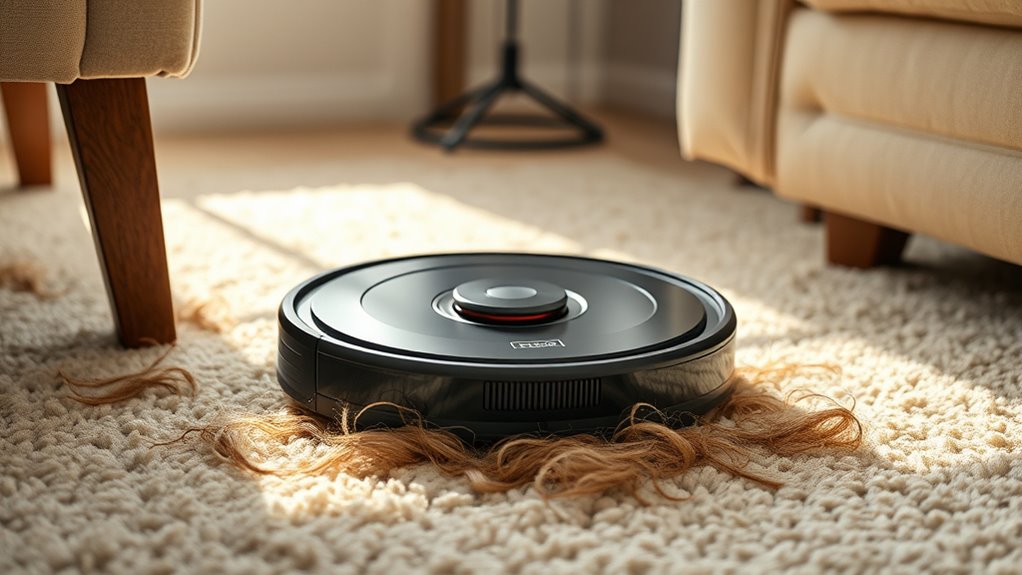
Robot vacuums have become a popular solution for cleaning up pet hair, especially for busy pet owners. When choosing a robot vacuum for your home, two key factors to consider are battery life and noise levels. These aspects substantially impact how well the device manages pet hair on a daily basis. A long-lasting battery ensures your robot can cover large areas without frequent recharging, making it more efficient at picking up pet hair from multiple rooms. If the battery drains quickly, you might find yourself stopping mid-clean to recharge, which can be frustrating if you’re aiming to keep your home tidy consistently. Opting for models with extended battery life allows for uninterrupted cleaning sessions, especially vital if you have a pet that sheds heavily.
A long-lasting battery and quiet operation make robot vacuums ideal for managing pet hair effectively.
Noise levels are equally important when dealing with pet hair. Many pet owners find their pets startled or distressed by loud vacuum noises, which can make the cleaning process stressful for everyone. Fortunately, many modern robot vacuums operate quietly enough to run while you’re relaxing, working, or even sleeping. Lower noise levels mean your pets won’t be scared off or disrupted during cleaning, which can help prevent stress or anxiety in your pets and ensure they stay calm and comfortable. Plus, quieter vacuums often allow you to monitor the cleaning process without feeling overwhelmed by noise, giving you peace of mind that your pet hair is being effectively addressed.
In real-world tests, these features often determine the vacuum’s overall performance with pet hair. A robot with a robust battery can handle larger spaces and multiple cleaning cycles, making it ideal for homes with shedding pets. Meanwhile, a model with reduced noise levels can run for longer periods without disturbing your pets, encouraging more frequent cleanings. When evaluating different options, look for reviews that mention how the vacuum performs over extended use and whether it maintains low noise levels during operation. Some advanced models even have smart sensors to optimize cleaning routes and avoid obstacles, which helps prevent missed hair patches and reduces the need for manual intervention.
Ultimately, the best robot vacuum for pet hair combines good battery life with quiet operation. These features not only make cleaning more convenient but also more effective, ensuring your home stays free of pet hair without causing stress to your furry friends. Paying attention to these factors during your selection process will help you find a device that fits your lifestyle, keeps your space clean, and keeps your pets happy.
Frequently Asked Questions
Do Robot Vacuums Work Better on Short-Haired or Long-Haired Pets?
You might find robot vacuums work better on short-haired pets because pet hair types are easier to pick up, and grooming impact is minimal. Long-haired pets shed more, creating hair that can tangle in brushes and clog filters, making cleaning less efficient. Regular grooming reduces shedding and helps your robot vacuum perform better. Overall, short-haired pet owners benefit from smoother, more effective cleaning with their robot vacuums.
How Often Should I Clean My Robot Vacuum’S Brushes After Pet Hair Cleanup?
You should clean your robot vacuum’s brushes regularly, ideally after every pet hair cleanup session. Brush maintenance prevents hair buildup, which can hinder performance and cause strain on the motor. By removing hair and debris promptly, you guarantee your vacuum continues to work efficiently. Regular cleaning also prolongs the lifespan of your device and maintains peak suction, especially when dealing with persistent pet hair.
Can Robot Vacuums Detect and Avoid Pet Sleeping Areas?
Did you know that many robot vacuums now feature advanced sensors? These sensors help detect and avoid pet sleeping areas, ensuring your pet’s comfort. While they can recognize common obstacles, they might not always perfectly detect soft spots like beds or sleeping zones. Incorporate these vacuums into your cleaning schedules to efficiently handle pet hair, but remember to occasionally check and adjust their routes for better pet area avoidance.
Are There Specific Robot Vacuum Models Recommended for Heavy Pet Hair?
You want to know which vacuum models excel at pet hair removal, especially for heavy shedding. Look for models with strong suction, advanced brush rolls, and HEPA filters. Recommendations include the Shark IQ, iRobot Roomba i7+, and Dyson V11. These vacuum models are designed to handle pet hair efficiently, making your cleaning routine easier. Always check for features targeted at pet owners to guarantee ideal pet hair removal.
How Do Robot Vacuums Handle Pet Accidents or Wet Messes?
Ever wondered how robot vacuums handle pet accidents or wet messes? While they’re great at regular cleaning, they aren’t designed for pet stain removal or wet mess cleaning. You’ll need a different solution, like a handheld carpet cleaner, for those situations. Robot vacuums excel at dry debris, but for wet messes, it’s best to act quickly and use specialized tools to guarantee thorough cleaning.
Conclusion
So, it seems like robot vacuums can handle pet hair surprisingly well, especially when you choose the right model. Coincidentally, just as I was about to give up on finding a solution, my robot cleaned up that stubborn fur mess I’d been battling for weeks. Sometimes, technology really does surprise us, syncing with our needs when we least expect it. In the end, with a little patience, your robot might just become your pet hair’s worst enemy.
